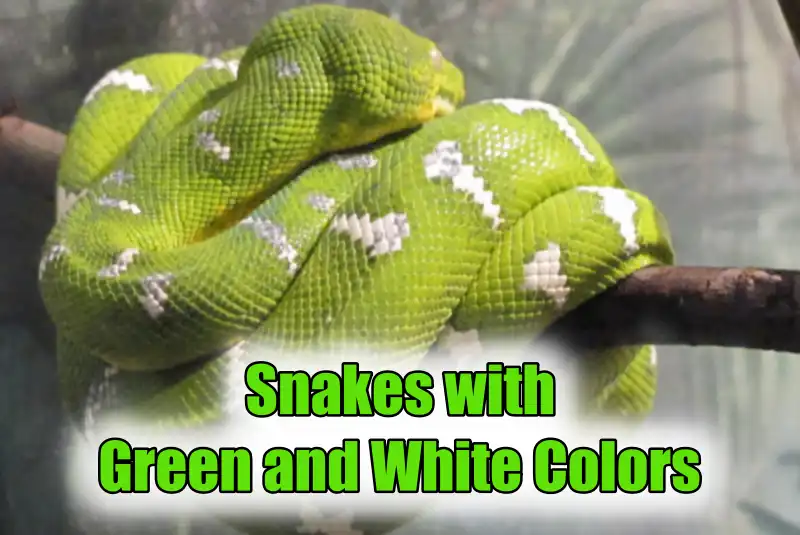Color variation is an important feature in the reptilian world. Snakes show a remarkable combination of colors, Such as Green-brown, red-white, etc. Here we will discuss about 15 such snakes that exhibit a combination of Green and white color in their body.
15 Snakes with Green and White Colors
1) Green Tree Python
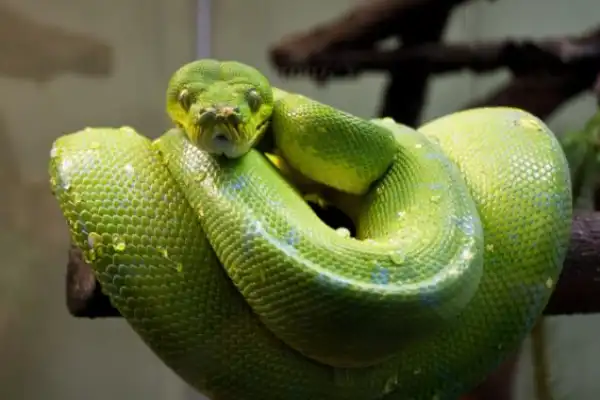
- Scientific name: Morelia viridis
- Size: Between 4 to 6 feet.
- Habitat: Generally found in Rainforests.
- Location: Australia, Indonesia, New Guinea.
These snakes are arboreal and prefer to live in the tree branches, coiling up. The interesting thing about their coloration is that they are usually born red or yellow, but later turn green in adult stages. The green body has many white spots.
Their diet can range from large mammals to small amphibians and reptiles.
Their tail is very strong and they use it to grasp the branches as well as to capture prey. They also have special heat-sensing pits which they use to detect potential prey in their surrounding.
2) Emerald Tree Boa
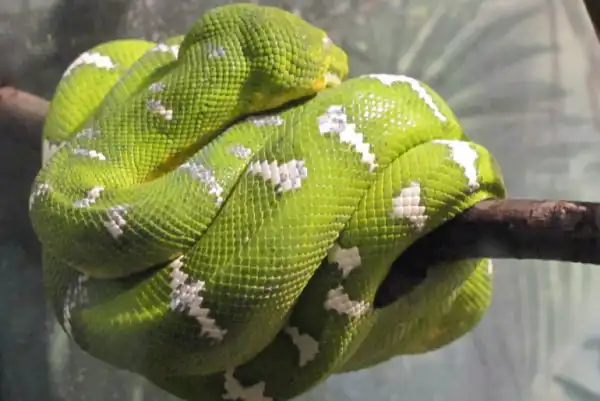
- Scientific name: Corallus caninus
- Size: Up to 6 feet.
- Habitat: Rainforests.
- Location: South America.
Oftentimes, these snake species are confused with the green tree python. This is due to Convergent evolution. The emerald tree python has a bulkier body compared to the slender tree python. Experts can also distinguish the two by looking at the shape of head scales and the position of heat-sensing pits.
The overall body color of these snakes is emerald green, with white zig-zag or irregular stripes. The belly is yellow.
3) Rough Green Snake
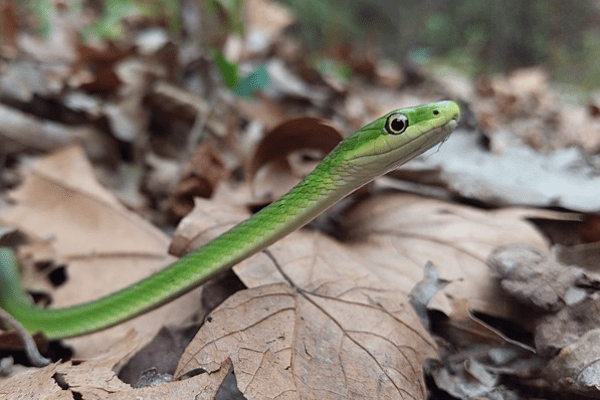
- Scientific name: Opheodrys aestivus
- Size: Between 22 to 32 inches.
- Habitat: Open forests, wetlands.
- Location: Various regions of the southeastern United States and northeastern Mexico.
These snakes have a very thin body covered with rough-keeled scales. They are very harmless, amenable, and don’t usually bite.
They have a green colored body, which helps them to hide behind thick vegetation. The belly color is white or whitish-yellow. Since they are very small, they fall prey to larger predators such as birds, and large snakes.
4) Smooth Green Snake
- Scientific name: Opheodrys vernalis
- Size: Up to 2 feet.
- Habitat: Moist areas, marshes, open woods, dense vegetation.
- Location: Generally found in Southeastern Canada, Mexico, and Missouri.
These snakes are in the same genus as rough green snakes, but there are slight differences between them. The body of Opheodrys vernalis is covered with smooth scales and their eyes are also smaller than rough green snakes.
Since they are very small and non-venomous, it’s easier for them to fall prey to larger predators. Apart from green camouflage, evolution has given them the ability to escape quickly and if they are cornered, they will bite and secrete a foul-smelling liquid.
5) Bornean Keeled Pit Viper
- Scientific name: Tropidolaemus subannulatus
- Size: Males are 46 cm, Females generally larger, 96 cm.
- Habitat: Riverine forests, Coastal forests.
- Location: Borneo, Sulawesi, Malaysia.
Also known as the ” North Philippine temple pit viper”, these snakes have a triangular-shaped head with many keeled horny scales, due to which they have a rough armor-like appearance.
These snakes show a wide variety of colors. The juveniles and adult males show vibrant green body color, with pale bicolored bars of white and blue-green. The females are creamy white and have turquoise-colored bands.
6) Long-Nosed Whipsnake
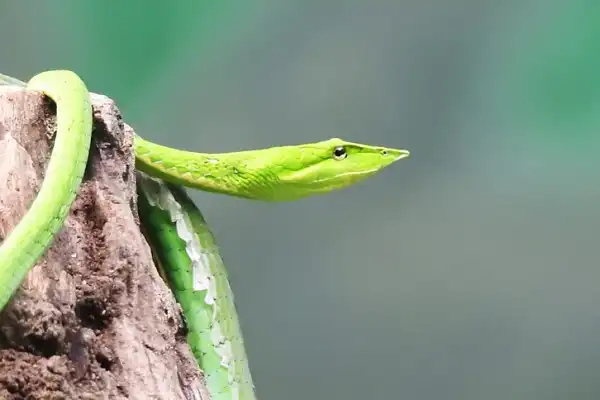
- Scientific name: Ahaetulla nasuta
- Size: Up to 4 feet.
- Habitat: Mainly resides in dense bushes and trees.
- Location: Sri Lanka, parts of India, Myanmar, Bangladesh.
These are commonly known as “eye-pluckers” because many people think that they first blind their prey with the help of their long pointed snout. They have a flat leaf-like head.
Their body is long and slender, whip-like. They are the only snake species that have horizontal pupils, compared to other snake species. Their eyes have a unique “binocular” like vision, which helps them to detect prey.
Usually, the snakes have a green body color, but when threatened or disturbed, they expand their body to show distinct black-and-white scale markings that spread through the body. They will also open their mouth to intimidate, which kind of looks as if they are laughing!
7) White-lipped Green pit viper
- Scientific name: Trimeresurus albolabris
- Size: Males are 24 inches, while females are 32 inches.
- Habitat: Tropical moist Forests, shrubland, and can also be found near human habitations.
- Location: They are endemic to Southeast Asia.
The body is vibrant green with a white ventrolateral line traveling from the head to the tail on the lateral side, although females usually don’t have this.
Eyes are bright yellow with vertical pupils. Head Scales are weakly keeled. The belly is yellowish-white.
8) Green Keelback (Juveniles)
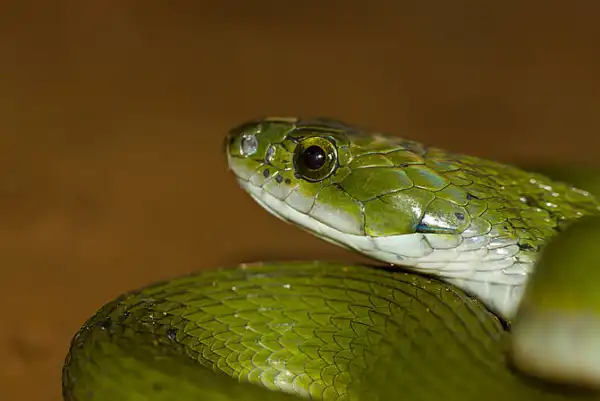
- Scientific name: Rhabdophis nigrocinctus
- Size: Can reach up to 2 feet.
- Habitat: Dense vegetation, bushes, and Hill forests.
- Location: Various parts of Peninsular India and Sri Lanka.
The adults of this snake species only have green coloration but the juveniles show multiple color variations. The Green body of juveniles usually has black stripes, and the lateral sides of the head have a whitish-blue colored region.
They are nocturnal hunters and don’t usually attack unless provoked multiple times. They will freeze themselves or run away if they feel threatened.
9) Rhino Rat Snake
- Scientific name: Gonyosoma boulengeri
- Size: Between 39 to a maximum of 59 inches.
- Habitat: Subtropical rain forests.
- Location: Indigenous snakes of China and Vietnam.
The most prominent characteristic of these snakes due to which they got the name “rhinoceros” snakes is the presence of scaly protuberance in the snout.
Like the vine snakes, these snake species show white, and sometimes black markings on the edge of the scales.
10) Green Bush Rat snake
- Scientific name: Gonyosoma prasinum
- Size: Maximum of 3 feet.
- Habitat: Forests and thick vegetation.
- Location: Bangladesh, India, Myanmar, Thailand.
These snakes are diurnal and arboreal in nature but sometimes they come down from the trees at night to find prey. They are relatively harmless and quiet in behavior.
The dorsal side is green and they have a yellowish and broad upper lip. The ventral side is white or greenish-white.
11) Baron’s Green Racer
- Scientific name: Philodryas baroni
- Size: Usually 59-71 inches.
- Habitat: Found in tropical and subtropical forests.
- Location: South America, Northern Argentina, Bolivia.
The snakes show variable colorations. The body is green with longitudinal black lateral stripes extending from the head to the anterior third of the body. The ventral area can be yellowish-white or sometimes greenish-blue.
The term racer is used since they are very fast and active and are able to use this speed to quickly catch prey or escape from a predator.
12) Flatbread Snake
- Scientific name: Oxybelis fulgidus
- Size: 1.5 to 2 meters on average.
- Habitat: Montane forests, tropical rainforests.
- Location: Endemic to Central and Northern America.
Oftentimes these snakes are confused with the Asian vine snakes, although they have some dissimilarities. The flatbread vine snakes have a dorsal green side and a ventral yellowish-green side. The most prominent feature is the presence of a yellowish-white line on the lateral sides and tail region.
These snakes are arboreal and mildly venomous. They carefully watch and wait for the prey to come near them and then the snakes attack their prey by biting in the head, immobilizing them by releasing venom.
13) Green Water Snake
- Scientific name: Nerodia cyclopion
- Size: 30 to 45 inches.
- Habitat: Mostly found in still waters such as marshes, lakes, and ponds.
- Location: Endemic to Southeastern United States.
These snakes have a dark olive-green dorsal side. The anterior half of the ventral side below the head is yellow, and the remaining half is dark brown with pale-white yellow spots.
These snakes mainly prey on small fishes, frogs, and salamanders and they are nocturnal hunters. They can remain hidden near the muddy region of slow-moving waters.
14) Eastern Green Mamba
- Scientific name: Dendroaspis angusticeps
- Size: Between 1.5 to 2 meters.
- Habitat: Dense and well-shaded vegetation such as tropical rainforests, and coastal forests.
- Location: Various parts of South Africa.
There’s a common myth regarding these snakes is that they are “people chasers” and aggressive, but in reality, they are very shy and remain hidden in the trees avoiding any detection. But they are venomous so it is better to avoid any close contact without professional help
The body has vibrant green coloration and the ventral side of the mouth region is whitish-yellow. The belly is usually yellow. The inside of the mouth of some snakes can be either white or bluish-white.
15) Angola Green Snake
- Scientific name: Philothamnus angolensis
- Size: Maximum of 1.2 meters.
- Habitat: Generally resides in lowland forests.
- Location: Found in Mozambique, Central Namibia, Eastern Zimbabwe.
The body color is emerald green and a pale greenish or white lower jaw. Sometimes, they inflate their neck due to which the black skin present between the scales becomes visible.
Oftentimes, these snakes are confused with the Green Mamba but these snakes are harmless, and some people might use them as pets also. They are also excellent climbers and diurnals.
Conclusion
It’s essential to note that the coloration pattern generally varies in different species as well as within a specific species population, and individual snakes might show different and unique color shades.
The variations can give rise to many different morphs of the same snake species. Environmental factors also affect the pattern of colorations, so the snakes in this list might also exhibit a different type of coloration.
Hi everyone. I am Sagnik. Biology has always fascinated me since my school days and that interest motivated me to pursue a Bachelor’s degree in Zoology and a Master’s degree in Biotechnology. I learned a lot of new interesting facts and information regarding the biological world we are part of. After obtaining my degree, I started working as a biology teacher through which I am able to teach students the various concepts that I have learned. Apart from my love for this subject, my passion lies in music, and I teach guitar as well. Photography, Reading comics, Drawing, and video editing are some of my other hobbies. I welcome you to a journey with me, where I will share my knowledge and excitement for the living world through my writings with you all.
